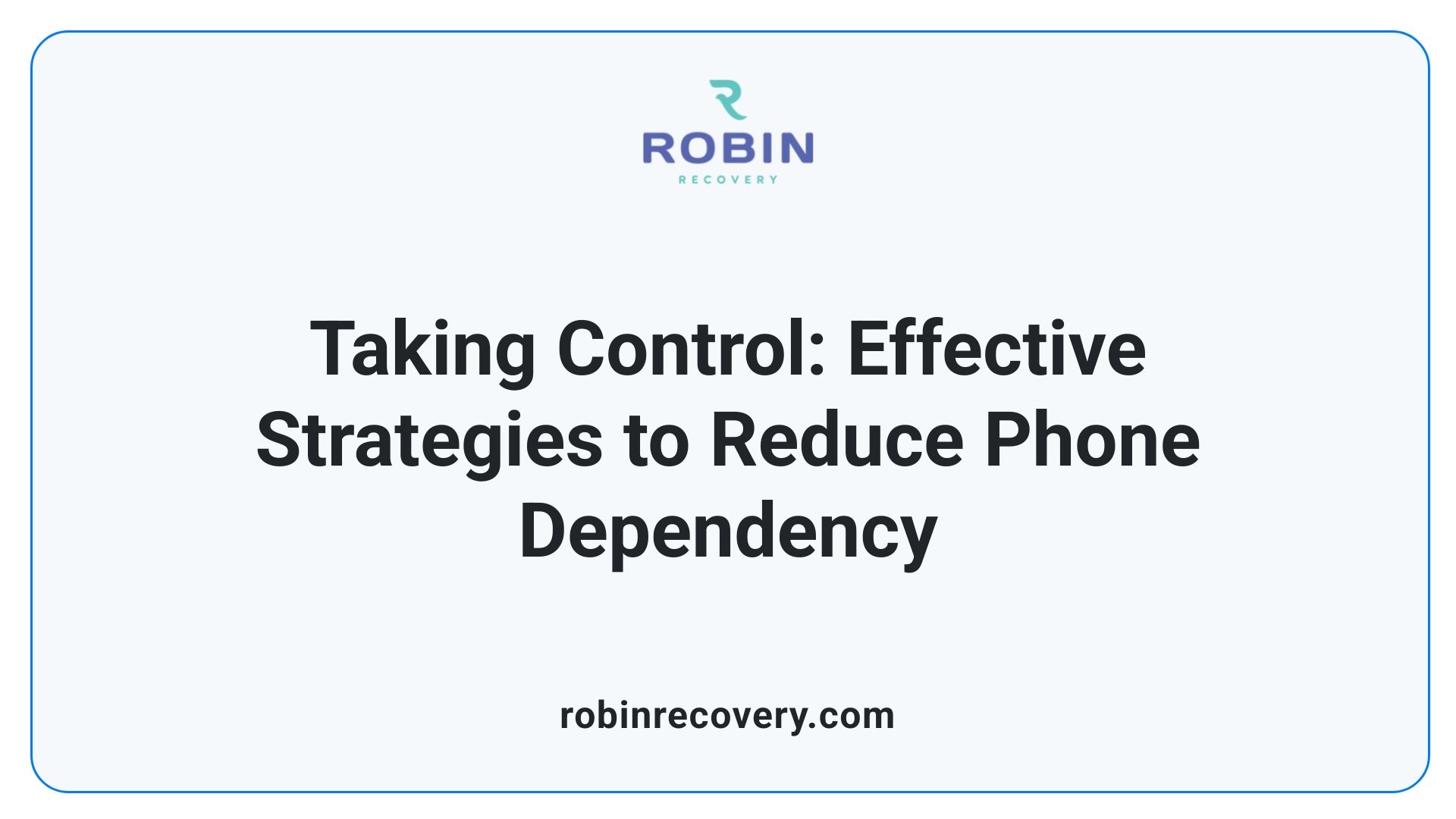Understanding the Roots of Phone Addiction in Students
Smartphone addiction is a growing concern, especially among students who increasingly rely on their devices for both academic and social interactions. While these devices offer essential connectivity, their potential to distract and dominate daily life can negatively impact students' academic performance and mental health. Understanding the causes and identifying the symptoms of phone addiction is the first step in managing this modern dilemma effectively. This article explores practical strategies, insights, and methods to help students overcome phone addiction and cultivate healthier relationships with their devices.
Recognizing Smartphone Addiction in Students

What are some symptoms of phone addiction in students and their potential impacts?
Many students exhibit signs of smartphone addiction which can deeply affect their daily lives. Common symptoms include:
- Anxiety when separated from their phone: Many students feel uneasy or restless when they don’t have access to their smartphone.
- Difficulty concentrating: The urge to check one’s phone can distract from studies and disrupt focus on important tasks.
- Withdrawal from real-life interactions: Excessive phone usage often leads students to prioritize screen time over face-to-face interactions with friends and family.
- Changes in sleep patterns: Late-night smartphone use can lead to sleep deficits, impacting overall well-being.
Such symptoms can have significant repercussions. Students may experience:
- Lower academic performance: Distraction from smartphone notifications can lead to missed assignments and reduced engagement in learning.
- Increased stress and anxiety: The constant need for validation through social media can heighten feelings of inadequacy and exacerbate mental health issues.
- Reduced physical health: Sedentary lifestyles linked to excessive smartphone use can lead to obesity and related health concerns.
Addressing these symptoms is crucial for improving both mental health and academic success among students, creating a healthier balance between technology use and daily life.
Identifying Triggers and Behavioral Patterns

Common triggers for phone use
Identifying the reasons behind smartphone use is crucial. Many individuals reach for their phones out of boredom, loneliness, or anxiety. Recognizing these triggers is the first step.
When students feel bored, they might scroll through social media; if loneliness strikes, they may send texts instead of meeting friends. Understanding these emotional prompts enables more intentional use of technology.
Understanding behavioral patterns related to smartphone addiction
Once triggers are identified, students can observe the patterns that arise. For instance, frequent smartphone checking can lead to anxiety, releasing cortisol and creating a cycle of dependence. To manage this, students might consider replacing phone habits with healthier activities, like reading or exercising, which provide a more constructive response.
Establishing boundaries is also essential. Students should designate specific phone-free times—perhaps during meals or while studying—to encourage more meaningful interactions and deeper concentration.
By practicing mindfulness about their phone use and reflecting on their habits, students can adjust their behaviors and mitigate the risks of addiction. Through these strategies, addressing the emotional triggers and habitual patterns can lead to a healthier relationship with technology.
Practical Strategies for Reducing Phone Dependency

What are the best ways to overcome phone addiction for students?
To overcome phone addiction, students can implement several effective strategies. First, monitoring phone usage helps to raise awareness of how often they reach for their devices, allowing for better control. Apps like Space and Moment can assist in auditing phone time, making students more mindful of their habits.
Setting specific phone-free times—like during meals or study sessions—encourages mindfulness and fosters deeper connections with those around them. Designating these boundaries creates a healthier environment for both focus and social interactions.
Turning off notifications can significantly reduce the stress response and anxiety triggered by constant alerts. This adjustment enhances focus and clarity of thought, allowing students to engage fully in their tasks. They might consider limiting notifications only to essential apps like Phone and Messages.
Limiting screen time, especially before bed, not only leads to better sleep routines but also decreases the habitual dopamine-driven checking of the phone throughout the day. Keeping the smartphone out of the bedroom while charging can improve sleep quality and encourage more mindful use during waking hours.
Additional Strategies
Here are some more strategies to integrate into daily life:
- Digital Detox Days: Schedule one day free from phone use each week.
- Mindful Usage: Engage in offline activities; consider hobbies like knitting or exercise when reaching for the phone.
- Physical Separation: Keep the phone in another room while studying to maintain focus.
- Creative Boundaries: Establish phone-free zones, like during family dinners, to cultivate richer interactions.
These practical approaches can help students regain control over their smartphone habits, ultimately leading to improved well-being and academic performance.
Creating an Environment Conducive to Focused Learning

What strategies help manage excessive phone use to improve academic focus?
To manage excessive phone use and boost academic focus, various strategies can be employed. One effective approach is to turn off notifications from non-essential apps. This reduces distractions and lessens the temptation to check the phone distractedly throughout study sessions.
Additionally, removing distracting apps from the home screen can streamline the user experience, making it easier to stay focused on academic tasks rather than getting lost in casual browsing. Setting specific phone-free periods or dedicated study zones encourages a disciplined approach to using technology.
Engaging with apps designed for self-control, like 'Space' or 'Forest', can help users track their smartphone usage and motivate them to construct healthier habits. These tools can illuminate wasted time on devices, allowing for a more mindful re-evaluation of technology habits.
Finally, consider participating in digital detox days. Taking time away from devices helps individuals assess their relationship with technology and supports personal growth. Such strategies can create a more focused learning environment, allowing students to engage fully in their studies without the pervasive interruptions from smartphone distractions.
The Role of Dopamine and Addiction Cycle

Understanding the addiction cycle
Smartphone addiction often resembles a cycle, heavily influenced by the release of dopamine within the brain. This neurotransmitter plays a significant role in the brain's pleasure centers. When individuals check their phones, they experience a quick hit of dopamine, creating a sense of temporary satisfaction. This pleasurable feeling encourages repeated use, establishing a habit that can spiral into dependence on the device.
How dopamine affects smartphone usage
For students, the habitual checking of devices can lead to a continuous pursuit of that dopamine rush. This cycle not only reinforces smartphone habits but can also diminish the enjoyment of other activities that do not trigger such immediate gratification. To break this cycle, students are encouraged to replace smartphone use with healthier activities that provide fulfillment without relying on the instant rewards of phone interaction.
Engaging in physical exercise, pursuing hobbies, or scheduling face-to-face interactions can significantly help in disrupting this cycle. By fostering new habits and reducing reliance on smartphones for dopamine boosts, students can promote a healthier relationship with technology and enhance their overall well-being.
Utilizing Technology to Combat Phone Addiction
How can technology be used to reduce dependence on phones?
In our tech-driven world, numerous applications can aid in reducing phone addiction. For instance, apps like 'Space' and 'Forest' empower users to monitor and limit their screen time. They provide features that encourage users to meet usage goals, thus fostering a healthier relationship with their devices.
Moreover, features built into smartphones, such as ‘Reduce Interruptions’ mode and utilizing grayscale, can help reduce distractions and the compulsive nature of checking notifications. By making the screen less visually stimulating, users are less likely to find themselves caught in the cycle of constant engagement.
Using technology to create healthier phone habits
Tracking apps are instrumental in providing insights into phone usage habits. By auditing how often and when you check your phone, you can set realistic goals based on your actual usage patterns.
Implementing strategies like turning off non-essential notifications allows for greater focus on tasks at hand, promoting mindfulness and awareness. Creating a designated phone spot—such as charging it away from the bedroom—helps establish boundaries, ensuring technology does not interfere with sleep or personal interactions.
| Strategy | Description | Benefits |
|---|---|---|
| Use Apps | Install apps like Space and Forest | Helps manage screen time effectively |
| Reduce Interruptions | Activate 'Do Not Disturb' or similar modes | Minimize distractions for better focus |
| Track Usage | Use monitoring apps | Gain improved insights into usage patterns |
| Mindfulness Techniques | Apply strategies like grayscale or limiting notifications | Encourage more intentional usage of technology |
By leveraging these technologies, you can take significant steps toward a healthier balance in your phone usage.
The Digital Detox: Resetting Phone Habits
What is a digital detox and how can it benefit students?
A digital detox involves deliberately reducing or eliminating smartphone use for a designated period to reset daily habits and patterns. For students, this might mean designating a phone-free day each week to engage in offline activities.
The benefits of adopting a digital detox are substantial. By stepping away from their devices, students can experience enhanced focus and mental clarity, free from constant notifications and distractions. Engaging in face-to-face interactions fosters stronger personal connections and improves emotional health.
Moreover, a structured break from technology can help mitigate feelings of anxiety associated with excessive phone use. This reset promotes mindfulness, allowing students to better evaluate their screen time and how it affects their daily life.
Benefits of a phone-free day
A phone-free day encourages students to explore hobbies and activities that don't involve screens, such as reading, exercising, or spending time with friends and family. Regular engagement in these activities can offer emotional rewards, reduce stress levels, and even boost creativity.
By incorporating a digital detox into their routine, students can develop healthier habits, improve well-being, and cultivate a balanced approach to technology. This shift not only enhances academic performance but also nurtures a more fulfilling social and personal life.
Balancing Smartphone Use with Offline Activities
How can engaging in offline activities help reduce phone addiction?
Engaging in offline activities provides students with tangible, rewarding alternatives to smartphone use. When students immerse themselves in hobbies like sports, arts, or music, they occupy time that could otherwise be spent on devices. This not only helps in reducing screen time but also encourages physical activity and creativity.
Moreover, these hobbies often foster social connections, offering chances to bond with peers in real life. For instance, participating in a local sports team can promote teamwork and camaraderie, counteracting the loneliness that excessive phone use can create. Mental relaxation is another benefit; dedicating time to hobbies allows the mind to unwind and recharge away from screen distractions.
Why should students encourage face-to-face interactions?
Scheduling regular face-to-face interactions can significantly bolster emotional health. Unlike virtual communications, in-person meetings often yield a deeper sense of fulfillment and connectivity. Activities like group study sessions or meetup clubs encourage collaboration, which is essential for personal growth.
Research suggests that limiting phone distractions during these interactions enhances the quality of conversations and strengthens relationships. By prioritizing in-person engagements, students can develop emotional resilience and create lasting memories that digital interactions can't replicate.
The Importance of Education and Support Systems
How can education and support systems assist in reducing phone addiction in students?
Education plays a vital role in tackling smartphone addiction among students. By informing them about the potential negative impacts of excessive smartphone use, schools can empower students to make conscious choices regarding their phone habits. Initiatives can include workshops that detail the risks associated with addiction, such as anxiety, impaired social interactions, and poor academic performance. This awareness is crucial in helping students recognize their triggers and avoid falling into compulsive phone-checking patterns.
Support systems are equally essential. Familial and peer support can provide students with the accountability they need to moderate their smartphone use. Engaging in open discussions about the role of technology in their lives fosters a healthy dialogue, encouraging students to share their challenges. Schools can implement structured programs where students can seek help from resources, including counselors and support groups. Encouraging collaborative efforts among families, schools, and communities lays the groundwork for a well-rounded approach to managing smartphone habits in today's digitally driven environment.
Key Topics in Education and Support Systems
| Topic | Description | Benefits |
|---|---|---|
| Educational Workshops | Programs teaching students about smartphone addiction and its effects. | Informed decision-making and self-awareness. |
| Open Communication | Creating environments where students can discuss their phone use without judgment. | Builds trust and accountability among peers and families. |
| Structured Support Programs | Offering guidance through counseling and peer support groups. | Provides coping strategies and emotional support. |
| Engaging Families | Inviting parents to be part of the conversation regarding media use and technology engagement. | Promotes responsibility and better habits at home. |
Understanding the Psychological and Behavioral Dimensions
What are the psychological effects of smartphone addiction?
Smartphone addiction, often characterized by compulsive usage, can have profound psychological effects. Frequent phone checking releases dopamine, creating a temporary sense of pleasure, which reinforces the habit. This cycle can lead to heightened anxiety when phones are not accessible—commonly referred to as 'nomophobia.' Studies suggest that 66% of smartphone users exhibit signs of addiction, significantly impacting their emotional well-being and social interactions.
In particular, adolescents, who typically spend about 9 hours daily on screens, are at heightened risk for conditions such as depression and anxiety due to excessive smartphone use. Symptoms may include irritability when separated from the device, as well as stress from an over-reliance on digital interactions. The disconnection from real-life social connections further compounds these issues since face-to-face interactions are essential for emotional health.
What psychological and behavioral interventions can help students manage phone addiction?
Cognitive-behavioral therapy (CBT) and mindfulness are effective interventions for managing phone addiction. These approaches help students recognize the psychological triggers of their habits, offering techniques to shift their responses and build healthier behavioral patterns. For example, a CBT session might explore how feelings of boredom or loneliness lead to phone usage and develop alternative coping strategies.
Additionally, real-world support networks, such as group therapy or Internet Tech Addiction Anonymous, encourage communal sharing of experiences and strategies. These settings provide a sense of accountability and support, promoting healthier habits among peers as they navigate their journeys toward reduced smartphone dependency.
| Intervention Techniques | Description | Benefits |
|---|---|---|
| Cognitive-Behavioral Therapy (CBT) | Helps identify triggers and modify behaviors | Develops coping strategies and resilience |
| Mindfulness Practices | Encourages present-moment awareness | Reduces impulsivity and anxiety, improves focus |
| Group Therapy & Support Networks | Promotes collective sharing and strategies | Builds accountability and communal support |
Encouraging Healthier Technology Relationships
Students face unique challenges in managing their smartphone usage, balancing the need for connections with the risk of addiction. By understanding the symptoms and psychological mechanisms behind phone addiction, students can apply practical strategies and support systems to develop healthier habits. Embracing phone-free periods, engaging in alternative activities, and utilizing technology wisely can transform the way students interact with their devices, leading to improved mental health and academic success. Encouraging ongoing education and open dialogue will be key to fostering responsible and mindful use of smartphones in the student community.
References
- Phone Addiction: Warning Signs and How to Get Help - HelpGuide.org
- 7 Proven Ways to Break Your Cell Phone Addiction
- 7 reasons to break your smartphone addiction - Piedmont Healthcare
- Phone Addiction: Warning Signs And Treatment
- Your Phone Addiction Makes You Less Happy. This Might Help.
- Tips on How To Fight Cell Phone Addiction | Cell Post Detail
- How to Beat an Addiction to Cell Phones: Tips to Get Off Your Phone
- 10 best tips on how to stop phone addiction for students
- How to Break Smartphone Addiction: Tips and Symptoms
- How to Stop Being 'Addicted' to Your Phone: 5 Tips | Psych Central

.svg)

.svg)

.svg)
.svg)






































































































